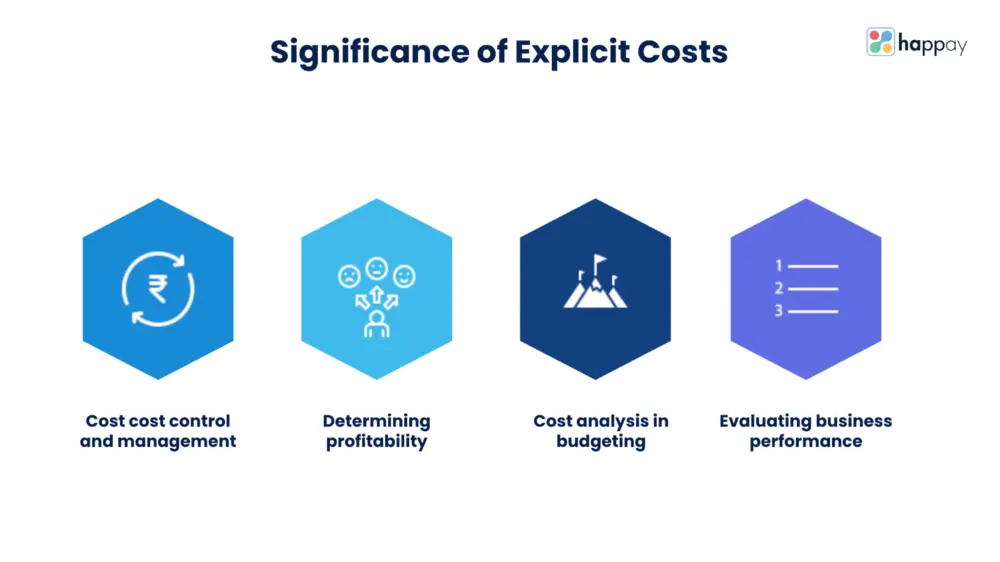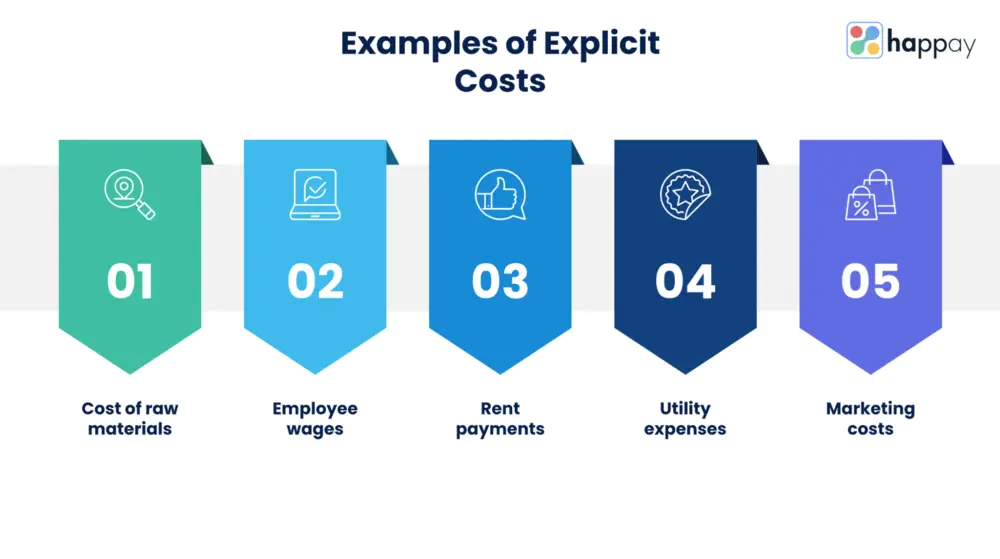Last Updated on November 28, 2025
Introduction to explicit cost
Explicit cost or explicit expense refers to a tangible and quantifiable expenditure resulting in a cash outflow from a company’s financial records. It helps create long-term strategic goals while evaluating profitability.
Differentiate explicit and implicit costs to gain valuable insights into the total economic cost. You can quickly identify them and make informed decisions accordingly.
Let’s examine explicit cost’s concept, significance, types, and ways to calculate it in your business. This analysis will help you maintain profitability and better plan long-term strategies.
What is explicit cost?
Explicit costs refer to monetary transactions made to others that result in cash outflows. These costs include wages, rent, utilities, advertisements, raw materials, and other general, administrative, and sales-related expenses. However, they do not include amortization or depreciation.
You can aggregate the business expenses in the general ledger or the income statement to determine your company’s explicit costs.
An expense to qualify as an “actual cost” should meet these conditions:
- The expense must involve a cash outflow.
- It should represent a tangible cost.
- The expense should be reflected in the firm’s financial statements.
Read More: What is Prime Cost? Formulas, Calculations and Applications
Understanding explicit costs
Explicit costs are readily identifiable expenses that you can directly link to specific business activities. These costs are recorded in the company’s general ledger and are reflected in the expenses listed on the income statement. A business’s net income (NI) represents the remaining income after all explicit costs have been settled.
Explicit costs play a fundamental role in calculating a company’s profit as they directly impact its bottom line. They are essential for strategic long-term planning within businesses.
For instance, when a company pays for advertisement space in a newspaper, the cash transaction is recorded as an actual expense in the income statement and general ledger, making advertisement expenses an explicit cost.
Conversely, when managers invest time in training their subordinates, the cost is intangible with no immediate cash outflow, making it a non-explicit expense that does not directly affect the company’s accounting costs.
Importance of explicit costs in business and economics
The explicit cost serves several vital purposes.
- Profit computation. Companies calculate two types of profit, accounting and economic. Accounting profit incorporates both implicit and explicit expenses, whereas economic profit considers only explicit expenses, making the explicit cost essential for this computation.
- Cost management. Finance departments focus on explicit expenses since they’re directly quantifiable and accountable, allowing for more effective cost control.
- Corporate strategic planning. Explicit cost is pivotal in determining a company’s profitability. As a critical metric for long-term strategic planning, it enables businesses to project their profits accurately for specific periods, aiding in informed decision-making and goal setting.
Read More: Financial Accounting: Definition, Types, Functions & Examples
Significance of explicit costs
Explicit costs are significant in assessing a company’s financial well-being. This evaluation directly reflects the explicit costs incurred by the company relative to its income. Unlike implicit costs, you can accurately measure explicit costs, making them a more simple reference point when evaluating a company’s financial health.

- Cost control and management. Since explicit costs are tangible and easily identifiable, they clearly understand the expenses incurred in various aspects of the business. It enables managers to track and regulate costs more effectively, ensuring the company operates efficiently and remains financially stable.
- Determining profitability and pricing decisions. Businesses can ascertain their net income by deducting explicit costs from total revenue. This information is crucial for making informed pricing decisions, as it helps set appropriate product/service prices that cover expenses while ensuring a competitive edge in the market.
- Cost analysis in budgeting and financial planning. Explicit costs are integral to budgeting and financial planning processes. When preparing budgets, organizations must account for explicit expenses to create accurate financial projections and allocate resources efficiently.
- Evaluating business performance and efficiency. You can identify areas of improvement by analyzing explicit expenses concerning revenue and other financial metrics.
Read More: TOP 10 Financial Planning Tools That Accelerate Growth
Types of explicit costs
Determining pricing relies on accurately classifying your explicit costs. When you precisely grasp the costs of manufacturing and delivering your goods or services to customers, you can set competitive and accurate pricing.
Moreover, it’s important to note that certain costs are eligible for tax deductions. You can optimize your deductions and reduce the tax burden by effectively tracking direct and indirect costs.
1. Direct costs
Direct costs refer to expenses a company can readily associate with a particular “cost object,” such as a product, department, or project. It encompasses various items like software, equipment, and raw materials.
Additionally, it comprises labor costs, provided that the labor is directly attributable to the product’s production, a department’s functioning, or a project’s execution.
2. Indirect costs
Indirect costs encompass expenses beyond the costs incurred in creating a product. They contain the broader costs associated with maintaining and operating a company. These overhead costs emerge after direct cost computation.
Read More: What is Prime Cost? Formulas, Calculations and Applications
Examples of explicit costs
Explicit costs are essential in calculating a company’s profit, as they directly impact its financial performance. Here are several explicit costs you should consider when calculating your accounting profit.

- Cost of raw materials and supplies. The supplies category includes expenses for paper and other materials necessary for office operations. Raw materials costs are expenses made on raw materials utilized in producing the company’s products or services that constitute an explicit cost.
- Employee wages and salaries. Salaries, wages, and contractual payments made to professionals for specific tasks are explicit costs incurred by the company. For example, payments made to consultants and contractors.
- Rent and lease payments. The recurring expense paid by the organization to maintain operational facilities is considered an explicit cost.
- Utility expenses. Costs related to utilities, such as electricity, that the company utilizes for its business operations are explicit expenses.
- Marketing and advertising costs. The expenses incurred by the company to market and promote its products are categorized as explicit costs in the general ledger.
Calculating and measuring explicit costs
Estimating explicit costs is pivotal to a company’s profitability and pricing calculations. Learn how to assess explicit costs in a business in the subsequent sections.
1. Importance of accurate cost measurement
Accurate costing allows businesses to make optimal decisions. It influences the measurement of gross margin and overall balance sheet. Recording costs correctly and using appropriate software mitigates inaccuracies and keeps the business on track.
Real-time data is crucial to handle the dynamic nature of freight prices and ensure accurate cost calculations. It empowers businesses to operate effectively, offer competitive pricing, and make optimal decisions based on reliable cost information, impacting gross margin and overall business success.
2. Methods of calculating explicit costs
Below are various methods of calculating explicit costs.
2.1 Actual expenses method
The actual expense method, approved by the Internal Revenue Service (IRS), allows individuals to claim business-related automobile expenses as valid deductions on their tax returns. To use this method, compile all actual costs incurred for operating the vehicle, including gas, oil, repairs, tire replacement, vehicle insurance, registration fees, licenses, and depreciation or lease payments (use the MACRS depreciation rate if applicable).
For instance, if the total expenses related to the vehicle operation for a specific year amount to $5,000, and the percentage of business-related miles driven that year is 60%, then the deductible vehicle-related expense for that year would be $3,000 (calculated as $5,000 total vehicle cost x 60% business usage).
2.2 Replacement cost method
The replacement cost method determines an asset’s value by considering the present-day cost of replacing it with a similar asset in a comparable condition, including applicable taxes. This method is based on the principle that buyers and sellers would not pay or accept more than the price of a similar asset. It can be applied to value both entire businesses and individual assets.
The replacement cost method exemplifies an asset-based approach to valuation, distinct from income-based or market-based approaches. This method involves identifying each asset within the business, applying a specific valuation approach to each asset, and then aggregating these values to arrive at the overall business value.
2.3 How do companies calculate explicit costs?
All businesses have different expenses. No one formula fits every business. You can calculate explicit costs by totaling all business costs, provided you’re aware of the business costs.
Add up the business costs to find the explicit cost. For example, if you pay Rs. 10000 as employee wages, Rs. 3500 as rent, and Rs. 1000 as utility expenses.
The explicit cost will be Rs. 14.500.
Total explicit costs = Cash flow going out from the company, which is recorded in a company’s financial statements.
Read More: What is Accrual Accounting: Meaning, Principles and Example
Challenges and considerations in measuring explicit costs
Below are some challenges and considerations one should consider while measuring explicit costs.
- Expense tracking. Measuring explicit costs requires meticulous tracking of all tangible and easily traceable expenses, which can be challenging, especially for businesses with complex operations and numerous cost components.
- Accuracy and completeness. Ensuring the accuracy and completeness of explicit cost data can be difficult, as companies may overlook some costs or incorrectly record them, leading to inaccuracies in financial statements and cost calculations.
- Cost allocation. Allocating explicit costs accurately to specific cost objects (e.g., products, departments, projects) can be intricate, particularly in cases where multiple cost objects are involved and costs are shared across various activities.
- Currency fluctuations. For international businesses, fluctuating exchange rates can pose challenges when converting expenses from different currencies to a common reporting currency for financial analysis and cost measurement.
- Evolving business operations. As businesses grow or undergo changes, their cost structures may evolve, making it necessary to regularly update cost measurement methodologies to adapt to the changing business landscape.
Explicit costs vs. implicit costs
Implicit costs are not easily quantifiable in monetary terms, making them challenging to track. These costs often represent the opportunity costs of choosing one course of action over another. For instance, consider a company that either invests in training its professionals or allocates resources to develop a new line of products.
Opting for one option implies forgoing the potential benefits of the other. If the company chooses to train its professionals, it loses the value that it could have generated from the new product line. On the other hand, pursuing the new product line means losing the value contributed by skilled and qualified professionals.
Differentiating explicit costs from implicit costs
Explicit costs |
Implicit costs |
|
|
1. Meaning |
Explicit costs arise when an entity incurs expenses for utilizing factors of production. |
Implicit costs denote the opportunity cost of using the owner’s resources, such as capital and inventory. |
|
2. Also called |
Explicit costs are out-of-pocket costs. |
Implicit costs are known as imputed costs. |
|
3. Ease of determining |
Determining explicit costs is straightforward since they leave a clear paper trail. |
Conversely, implicit costs lack a tangible paper trail, making their assessment more challenging. |
|
4. Occurrence |
Explicit costs are objectively measurable as they are incurred directly. |
Implicit costs are subjectively measured as they occur indirectly. |
|
5. Profits |
Accounting and economic profit calculations involve explicit costs |
Only economic profit considers implicit costs |
|
6. Management |
Explicit costs are reported to management. |
Implicit costs are neither recorded nor formally reported to management. |
Must Read: Cash Flow Statements: A Comprehensive Guide
Explicit costs in decision-making
Below are ways of using explicit costs to make informed decisions regarding several business-critical activities.
1. Role of explicit costs in production decisions
By accurately tracking and understanding these costs, businesses can make smart choices about the quantity and quality of products to manufacture.
Explicit costs help determine the minimum price at which products should be sold to cover expenses and achieve desired profit margins. They also aid in evaluating the cost-effectiveness of various production methods, identifying potential cost-saving opportunities, and optimizing resource allocation.
Through explicit cost analysis, businesses can maintain cost efficiency, maximize profitability, and ensure that production decisions align with their financial objectives.
2. Explicit costs in make-or-buy decisions
In make-or-buy decisions, explicit costs help compare the costs associated with producing a product or service in-house (making) versus outsourcing it from external suppliers (buying).
Explicit costs include direct expenses like raw materials, labor, overhead, and equipment, which are straightforward to quantify. By thoroughly analyzing explicit costs, businesses can accurately assess the cost implications of both options and determine which approach is more cost-effective.
If the explicit costs of making are lower than buying, it may be more advantageous for the company to produce internally. Conversely, outsourcing becomes viable and cost-efficient if the explicit buying costs are lower.
3. Explicit costs in investment and expansion decisions
Explicit costs are integral in investment and expansion decisions as they represent the measurable expenses incurred when acquiring new assets, expanding operations, or undertaking projects. These costs include tangible assets such as equipment, machinery, labor, construction, and administrative expenses.
You can carefully assess explicit costs to estimate the financial outlay required for the investment or expansion. Evaluating explicit costs against potential returns enables businesses to gauge the profitability and feasibility of the investment or expansion opportunity.
Read More: Expense Accounting: Meaning, Types, Methods, Procedures & Software
Explicit costs in different business scenarios
Below are scenarios where assessing explicit costs helps organizations.
1. Start-ups and explicit costs
Startup costs encompass the expenditures accrued while establishing a new business. Pre-opening startup costs consist of business plan expenses, research costs, borrowing expenses, and technology investments.
Post-opening startup costs involve advertising, promotion, and employee-related outlays. It is important to note that various business structures (sole proprietorships, partnerships, and corporations) entail distinct startup costs. Thus, understanding the specific costs associated with your new venture is essential.
2. Established businesses and explicit costs
For established businesses, explicit costs remain an ongoing consideration to maintain efficient financial management. These quantifiable and identifiable expenses encompass various operational aspects such as wages, utilities, raw materials, and marketing expenditures.
Careful tracking and controlling explicit costs allow established businesses to optimize resources, assess profitability, and make informed decisions to ensure continued success.
3. Explicit costs in service-based industries
In service-based industries, explicit costs are significant in financial planning and operational efficiency. These costs involve quantifiable expenses related to delivering services, such as labor wages, professional fees, equipment, and administrative overheads.
Service-based businesses can price their offerings by accurately monitoring and managing explicit costs, achieving profitability, and delivering quality service.
4. Impact of technology and automation on explicit costs
Technology and automation profoundly impact explicit costs by streamlining processes and reducing manual labor expenses in various industries. Automated systems optimize resource allocation, minimize human error, and enhance operational efficiency, saving costs.
Advanced technologies enable businesses to accurately track and analyze explicit costs, making informed decisions to control expenses and improve overall financial performance.
Read More: Financial System: What is it, Importance, Components, Functions & Challenges
Bottom line
Explicit costs refer to the actual out-of-pocket expenses that a business incurs in producing goods or services, easily identifiable and directly associated with a particular activity or business function.
Precise tracking of explicit costs enables businesses to make informed choices regarding pricing, production, and resource allocation, ensuring effective resource management and sound financial decision-making.
It is vital for businesses to carefully monitor their explicit costs to maintain optimal resource utilization and financial stability.
Explicit costs – FAQs
Explicit costs encompass quantifiable and identifiable business operating costs or expenses.
Explicit costs arise when the entity pays for utilizing factors of production. On the other hand, implicit costs represent the opportunity cost incurred when the entity uses its owner’s resources, such as capital and inventory.
Examples of explicit business costs include employee wages, utility bills, raw materials, rent, and marketing expenditures.
Explicit costs directly influence pricing decisions by serving as a crucial factor in determining the minimum price at which companies should sell a product or service to cover these expenses and achieve a desired profit level.
The significance of explicit costs in budgeting and financial planning lies in their clear and measurable nature, enabling businesses to accurately allocate resources, forecast expenses, and make informed decisions for effective financial management.
Explicit costs help evaluate business performance and efficiency by providing a concrete and measurable basis for analyzing expense patterns, identifying cost-saving opportunities, and comparing actual costs against budgeted amounts to assess financial performance.
No, explicit costs can vary among different types of businesses based on their unique operations, industry, and cost structures.
Explicit costs influence decision-making in production and investment by clearly understanding the direct expenses of each option, helping businesses make informed choices based on cost-effectiveness and profitability considerations.
Yes, explicit costs can be reduced or controlled through various cost-cutting measures, negotiation strategies, efficient resource allocation, and effective financial management practices.
Explicit costs can significantly impact start-ups, as they often face tighter financial constraints and must carefully manage expenses from the beginning. In contrast, established businesses may have more financial stability and better cost-control mechanisms.
Technology and automation can significantly impact explicit costs by streamlining processes, reducing manual labor expenses, optimizing resource utilization, and enabling more efficient operations, ultimately leading to cost savings and improved financial performance.
Yes, explicit costs incurred for legitimate business are generally tax-deductible, reducing a company’s taxable income and lowering its overall tax liability.
Yes, explicit costs can be used as a benchmark for comparing businesses, providing insights into cost structures and efficiency levels across different companies or industries.
Understanding explicit costs enables businesses to identify cost-saving opportunities, optimize resource allocation, and make informed pricing and investment decisions, ultimately leading to improved profitability and financial performance.
Yes, implementing lean management, negotiating better supplier deals, adopting cost-effective technologies, and optimizing operational processes are some strategies to minimize explicit costs without compromising quality.
Yes, explicit costs can change over time due to inflation, fluctuations in market prices, changes in supplier agreements, technology advancements, and shifts in business operations or expansion.










Discussion about this post